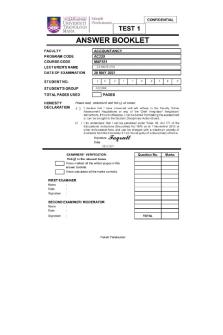Test1 - test PDF

| Title | Test1 - test |
|---|---|
| Course | Introductory Microeconomics |
| Institution | Ryerson University |
| Pages | 2 |
| File Size | 120.7 KB |
| File Type | |
| Total Downloads | 5 |
| Total Views | 178 |
Summary
test...
Description
test 1 Student: ___________________________________________________________________________
1.
The marginal cost curve is: A. upsloping because of increasing marginal opportunity costs. B. upsloping because successive units of a specific product yield less and less extra utility. C. downsloping because of increasing marginal opportunity costs. D. downsloping because successive units of a specific product yield less and less extra utility.
2.
The production possibilities curve shows: A. the various combinations of two goods that can be produced when society employs all of its scarce resources. B. the minimum outputs of two goods that will sustain a society. C. the various combinations of two goods that can be produced when some resources are unemployed. D. the ideal, but unattainable, combinations of two goods that would maximize consumer satisfactions.
3.
If an economy is operating inside its production possibilities curve for consumer goods and capital goods, it: A. can only produce more consumer goods by producing fewer capital goods. B. can only produce more capital goods by producing fewer consumer goods. C. can produce more of both consumer goods and capital goods by using resources that are currently idle. D. must improve its technology to produce more output.
4.
In economics, the pleasure, happiness, or satisfaction received from a product is called: A. marginal cost. B. rational outcome. C. status fulfillment. D. utility.
5.
Which of the following most closely relates to the idea of opportunity costs? A. tradeoffs. B. economic growth. C. technological change. D. capitalism.
6.
Refer to the above graph. Which of the following statements is correct? A. Quantity demanded and quantity supplied are independent of price. B. Price and quantity demanded are directly related. C. Price and quantity supplied are directly related. D. Price and quantity supplied are inversely related.
7.
Refer to the above diagram for athletic shoes. If the current output of shoes is Q1, then: A. society would consider additional units of shoes to be more valuable than alternative uses of those resources. B. society would consider additional units of shoes to be less valuable than alternative uses of those resources. C. society would experience a net loss by producing more shoes. D. resources are being allocated efficiently to the production of shoes.
8.
Ben says that "An increase in the tax on beer will raise its price." Holly argues that "Taxes should be increased on beer because college students drink too much." We can conclude that: A. Ben's statement is normative, but Holly's is positive. B. Holly's statement is normative, but Ben's is positive. C. Both statements are normative. D. Both statements are positive.
9.
Refer to the above diagram. Technological advance that is useful in producing consumer goods but not in producing capital goods is shown by the shift of the production possibilities curve from AB to: A. CD. B. EB. C. AF. D. GH.
10. Economics may best be defined as the: A. interaction between macro and micro considerations. B. social science concerned with how individuals, institutions, and society make optimal choices under conditions of scarcity. C. empirical testing of value judgments through the use of logic. D. use of policy to refute facts and hypotheses. 11. Macroeconomics can best be described as the: A. analysis of how a consumer tries to spend income. B. study of the large aggregates of the economy or the economy as a whole. C. analysis of how firms attempt to maximize their profits. D. study of how supply and demand determine prices in individual markets. 12. A well-tested economic theory is often called: A. an hypothesis. B. a prototype. C. a principle. D. an anomaly....
Similar Free PDFs

Test1 - test
- 2 Pages

Test1 - Test Derecho Empresa II
- 3 Pages

Practice test1
- 5 Pages

SQL TEST1 - sql 1
- 2 Pages

Answers to Test1 Econ141
- 4 Pages

ECON2030 Notes for Test1
- 24 Pages

Numerical Reasoning Test1 Solutions
- 23 Pages

LAB Report Flame Test1
- 7 Pages

1aa3 2012 test1 solutions
- 23 Pages

Cs166 test1 review mark stamp
- 6 Pages

WTW114 Sem Test1 2016 Memo 196457
- 10 Pages
Popular Institutions
- Tinajero National High School - Annex
- Politeknik Caltex Riau
- Yokohama City University
- SGT University
- University of Al-Qadisiyah
- Divine Word College of Vigan
- Techniek College Rotterdam
- Universidade de Santiago
- Universiti Teknologi MARA Cawangan Johor Kampus Pasir Gudang
- Poltekkes Kemenkes Yogyakarta
- Baguio City National High School
- Colegio san marcos
- preparatoria uno
- Centro de Bachillerato Tecnológico Industrial y de Servicios No. 107
- Dalian Maritime University
- Quang Trung Secondary School
- Colegio Tecnológico en Informática
- Corporación Regional de Educación Superior
- Grupo CEDVA
- Dar Al Uloom University
- Centro de Estudios Preuniversitarios de la Universidad Nacional de Ingeniería
- 上智大学
- Aakash International School, Nuna Majara
- San Felipe Neri Catholic School
- Kang Chiao International School - New Taipei City
- Misamis Occidental National High School
- Institución Educativa Escuela Normal Juan Ladrilleros
- Kolehiyo ng Pantukan
- Batanes State College
- Instituto Continental
- Sekolah Menengah Kejuruan Kesehatan Kaltara (Tarakan)
- Colegio de La Inmaculada Concepcion - Cebu




